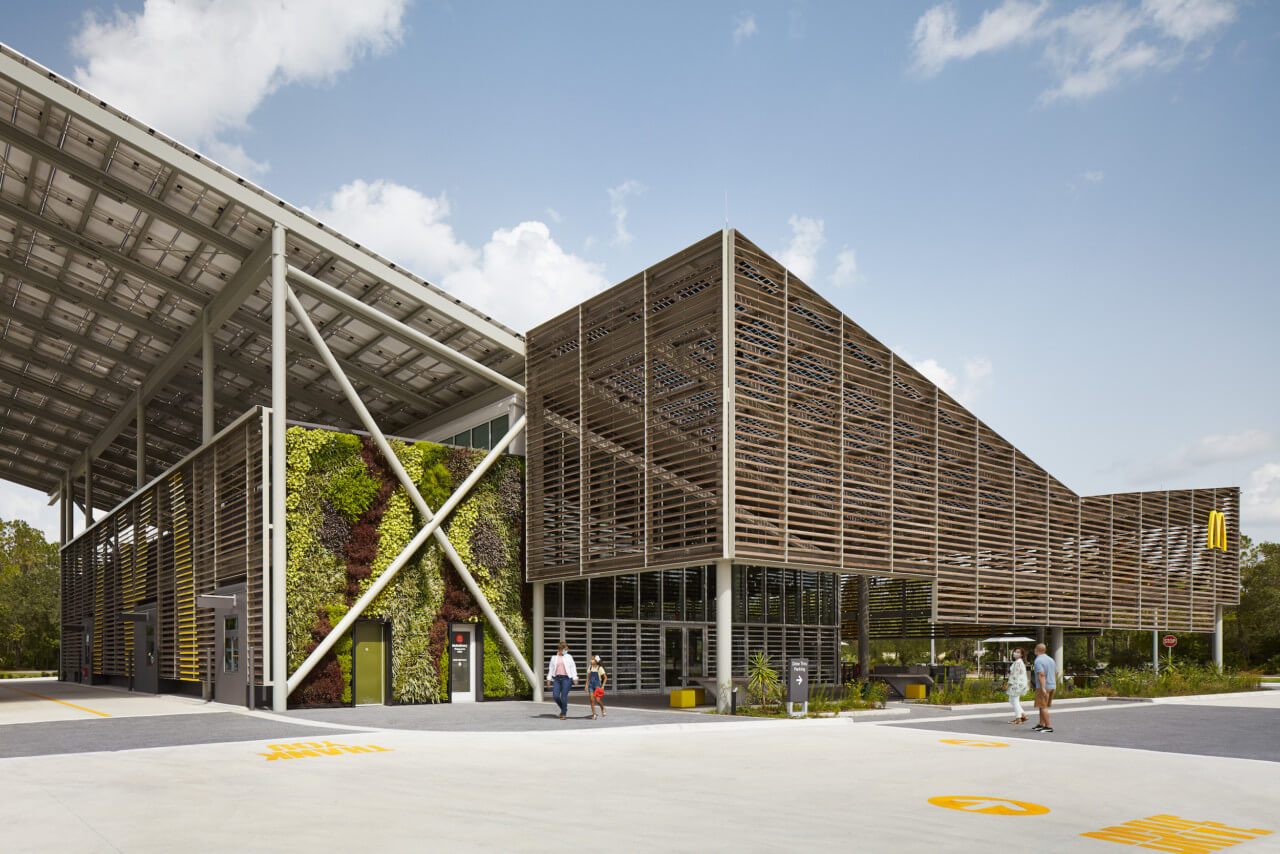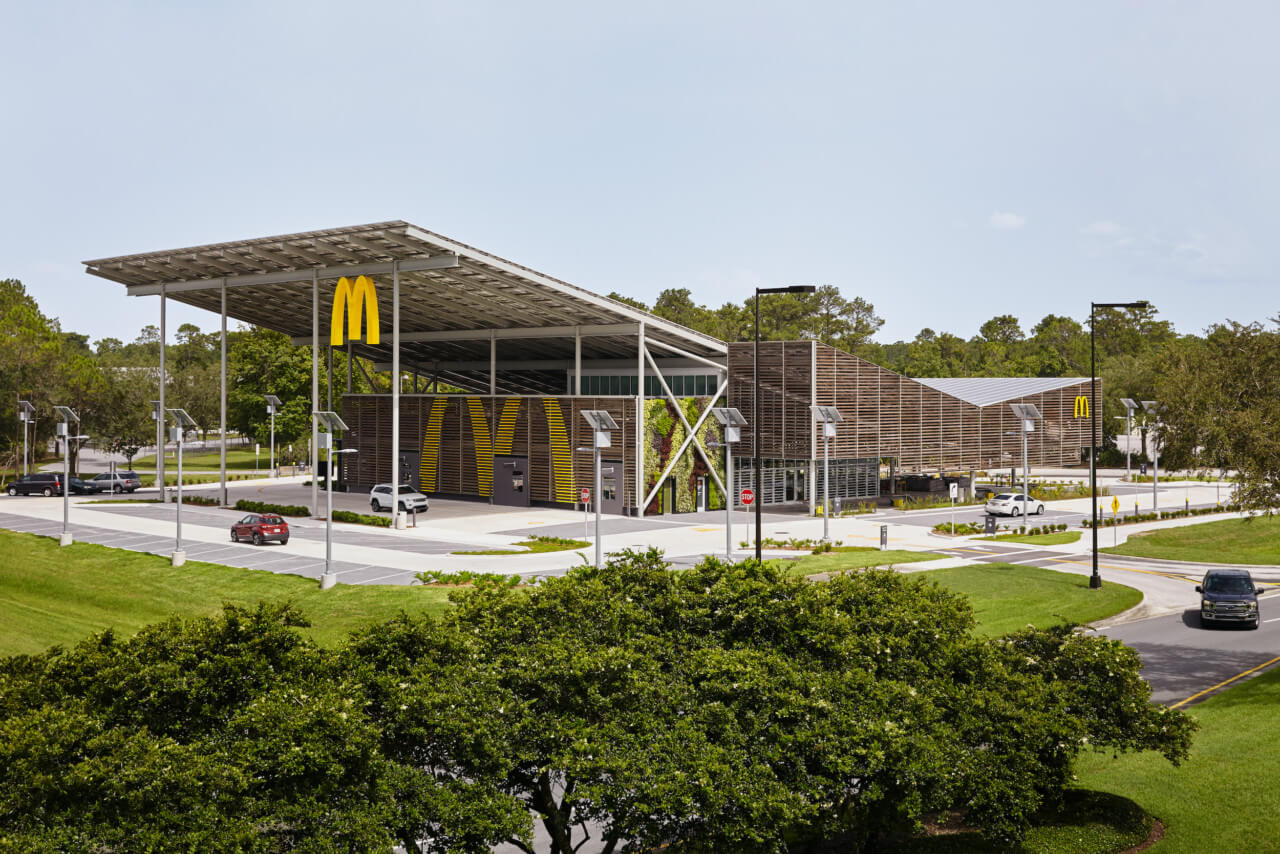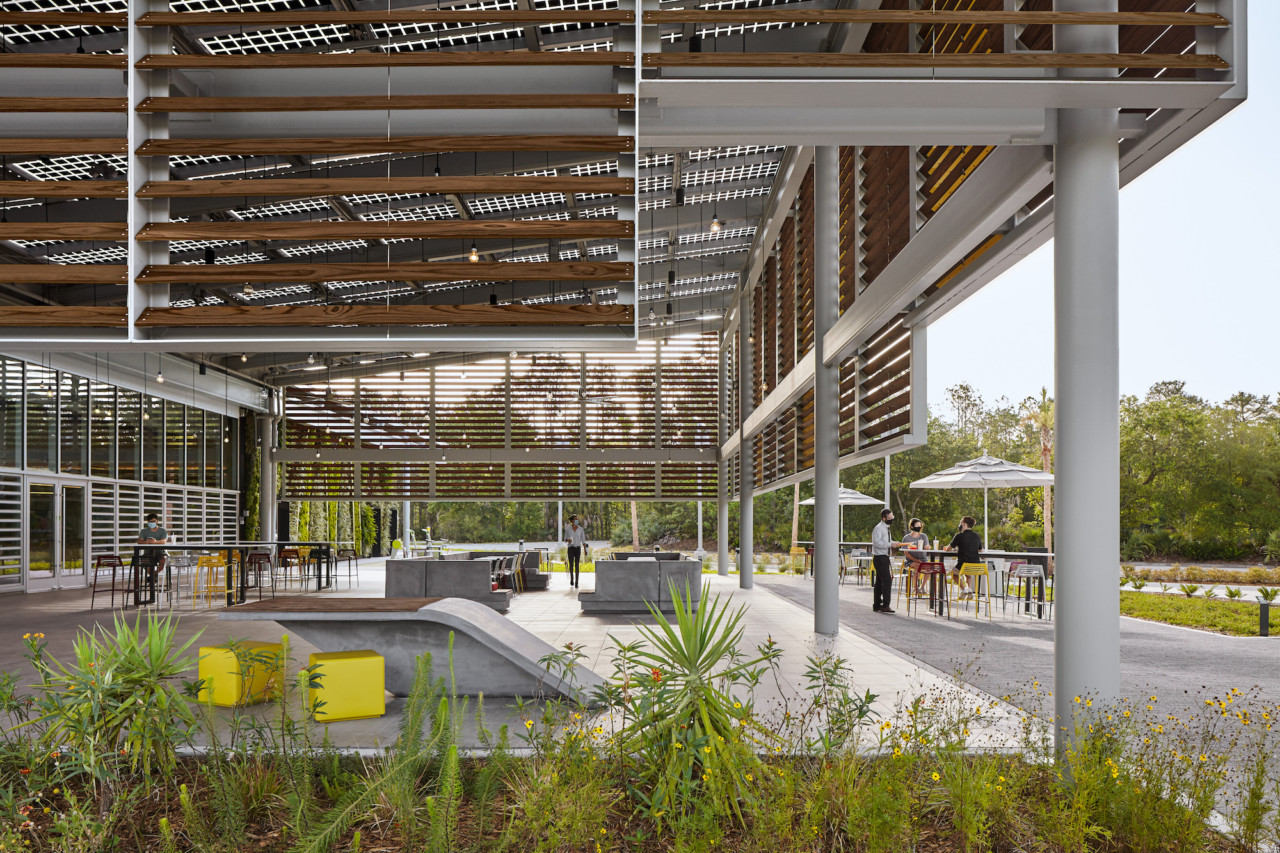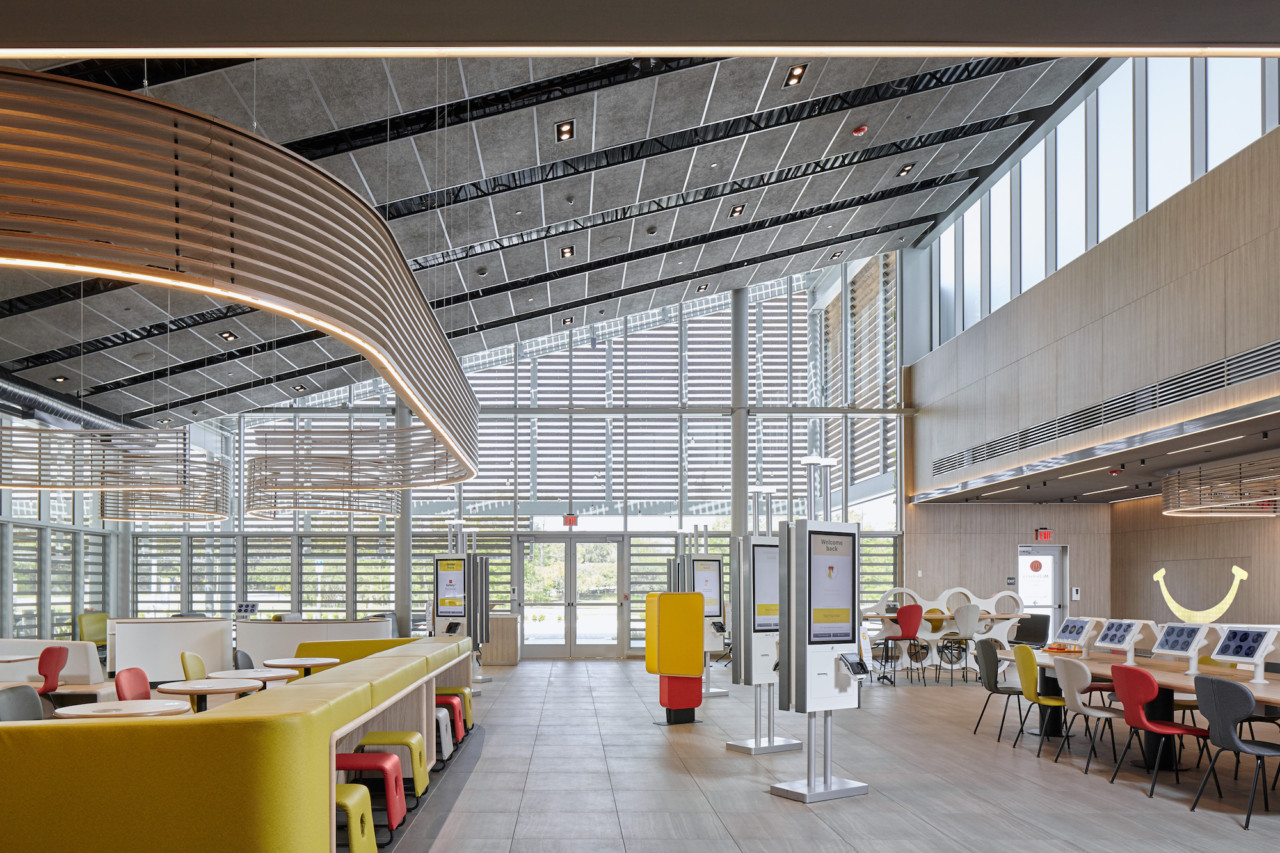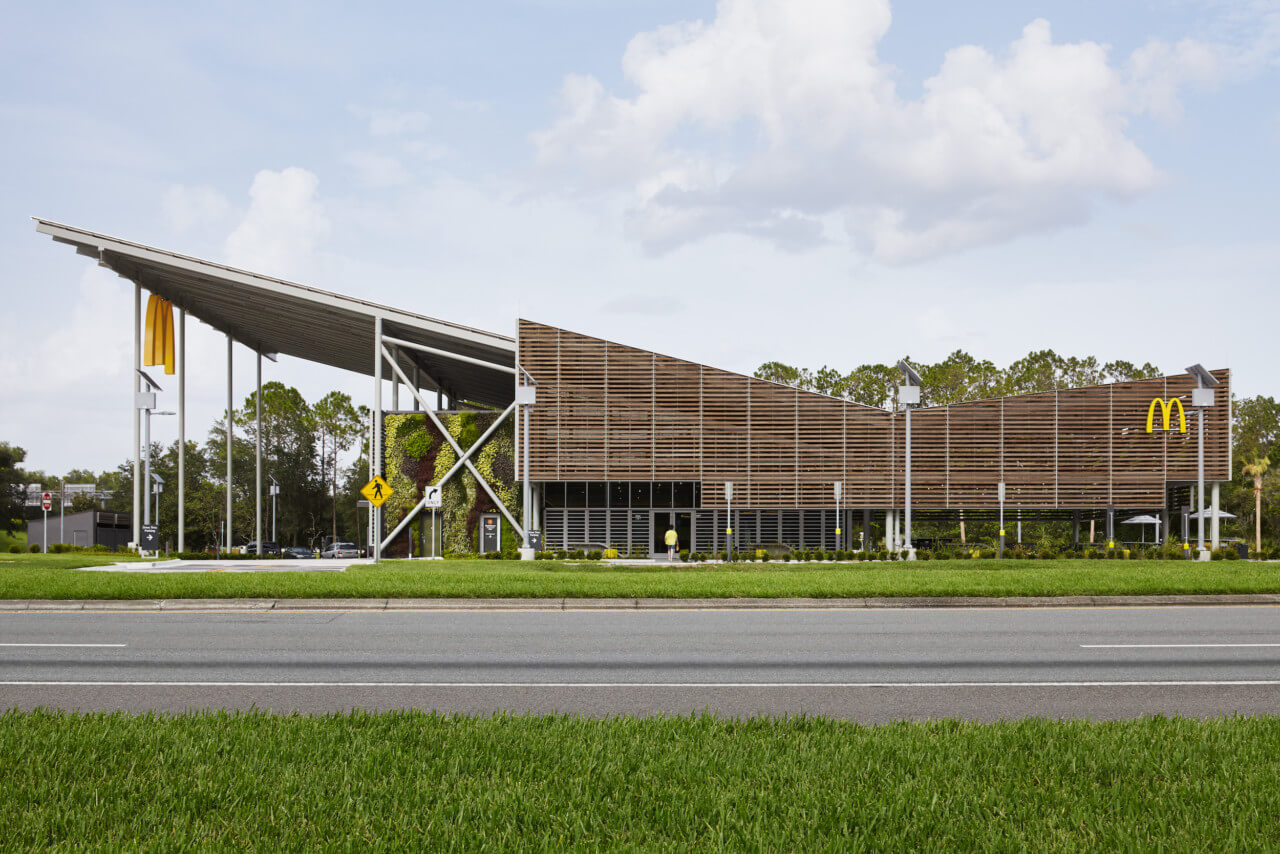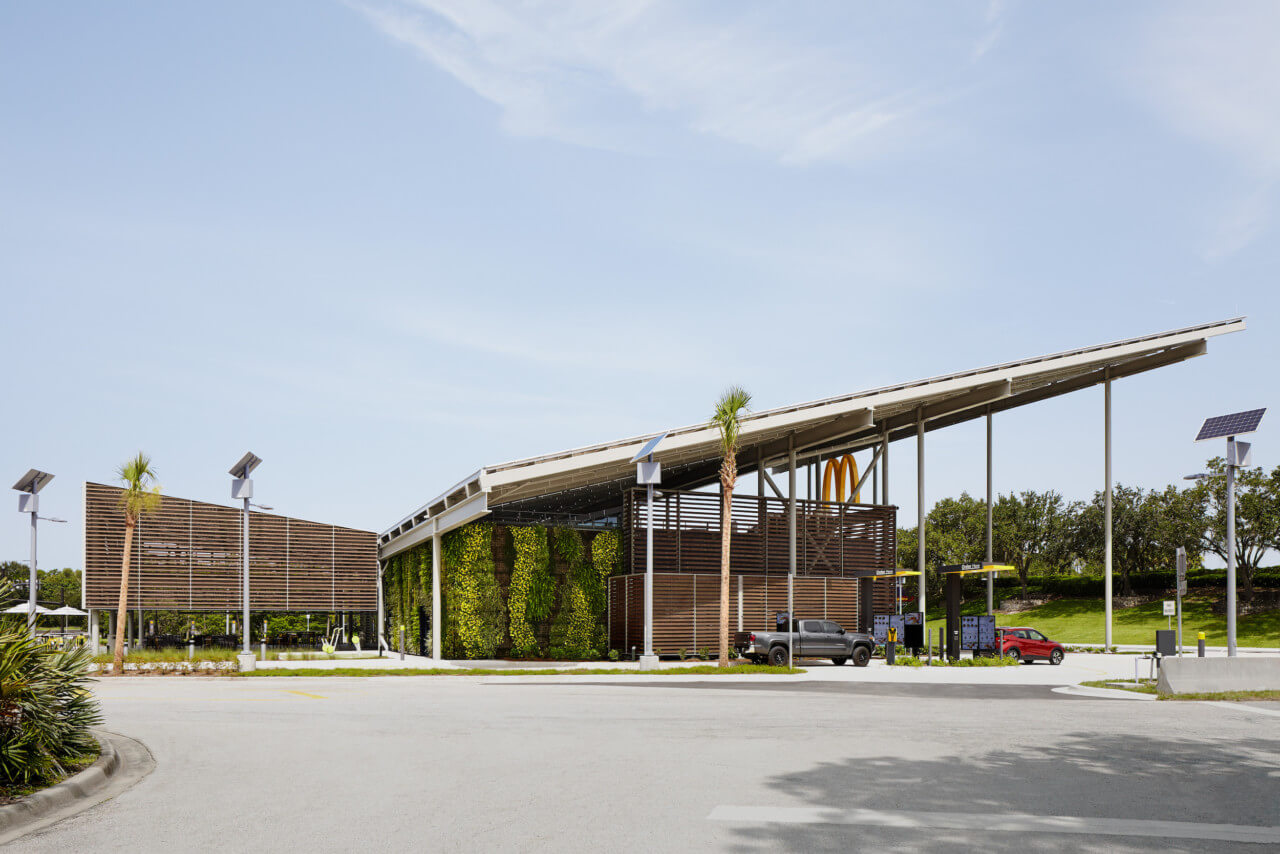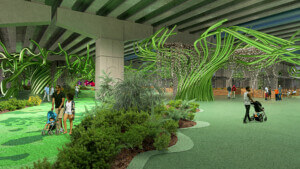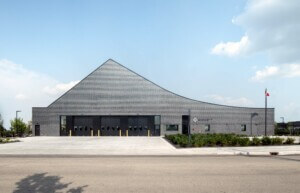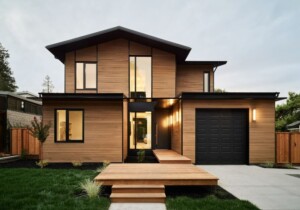Although Chicago-based architecture and urban design studio Ross Barney Architects has completed a wide breadth of projects over the nearly 40-year history of the firm in the Midwest and beyond, it has also earned itself a niche reputation as being a go-to designer for superlatively sustainable quick-service restaurants—namely, McDonald’s.
The firm has now designed two restaurants for the Chicago-headquartered fast-food behemoth. While not a substantial number, the deep-green buildings have garnered headlines and helped to change the mindset of what consumers think a fast food joint should look like.
It all started in 2018 with the LEED Platinum McDonald’s flagship location in Chicago’s River North neighborhood. A 19,000-square-foot steel, glass, and cross-laminated timber structure flanked by greenery and topped with a vegetated roof and solar array, the new flagship was built on the same footprint of its predecessor, reusing the building’s existing kitchen but swapping out the high-kitsch “rock ‘n’ roll” theme for a dramatic new modern look.
The firm’s relationship with McDonald’s has now expanded outside of the home turf of both architect and client to the grounds of the Walt Disney World Resort in Lake Buena Vista near Orlando. Located roughly equidistance between Disney’s Hollywood Studios and Disney’s Animal Kingdom, the recently opened (with some adjustments due to the coronavirus pandemic) McDonald’s net-zero flagship is a true first-of-its project as the only quick-service restaurant to aim for Net Zero Energy Building certification from the International Living Future Institute.

Like the Chicago flagship, the new McDonald’s flagship at Walt Disney World Resort is taking the place of a previous McDonald’s location—in this case, an appropriately, joyfully conspicuous Venturi Scott Brown-designed building completed in 1998 and revamped in 2009. As noted by the Smithsonian Magazine, Venturi Scott Brown described their design as a “a classic example of American commercial architecture defined by signage and symbolism within a roadside context whose conventional order we tweaked, in cooperation with McDonald’s.”
Like with its Chicago project, Ross Barney Architects reused and incorporated as much as it could from the existing building into the new one, which has a footprint of 8,000 square feet plus a nearly 6,000 square foot covered patio area—or lanai, since this is Florida, after all. Just as Venturi Scott Brown’s Happy Meal-inspired building embraced narrative storytelling in its design, so does the new building. But in lieu of focusing on McDonald’s history and lore, the new flagship’s forward-looking design aims to weave together a narrative that champions environmental stewardship.
While the ultimate goal of both the Chicago and Disney World McDonald’s flagship restaurants are the same—creating a high-traffic, high-profile fast-food eatery with as light of environmental impact as possible—their respective outsets couldn’t have been more different as Carol Ross Barney, founding principal of Ross Barney Architects, explained it.
“When McDonald’s came to us to do the Chicago flagship, they really didn’t talk about sustainability at all—they just wanted a refresh of the flagship,” Ross Barney explained to AN. “When we started doing the research for the design, we got into their corporate values, and one of their most important values is sustainability,” said Ross Barney. “And they’ve made some really big commitments like being zero energy by 2030.”
While impressive, most of the company’s sustainability efforts, however, were initially focused on its supply chain, and not on buildings.
“Why not try buildings?” Ross Barney recounted of the firm’s sustainability pitch to McDonald’s. And while the company showed some hesitation due to the nature of its business and past stabs at an ultra-green building that never came to fruition, the firm didn’t waver. “We said: ‘We’re going to make you the most sustainable McDonald’s because that’s where your corporate values say you should be’—and we proposed to them a LEED Platinum store,” said Ross Barney. (In 2008, the firm completed work on the first LEED Platinum house of worship in the form of the Jewish Reconstructionist Congregation Synagogue in Evanston, Illinois.)
The nudging on the firm’s part worked and McDonald’s was ultimately “super pleased” with the results according to Ross Barney. And so when Ross Barney Architects was approached about the Orlando project, persuasion to take an all-out sustainable approach wasn’t needed.
“Instead of us suggesting what the goal was, they started out by telling us that this store will be net-zero,” said Ross Barney. “So they threw it out there, not us.”
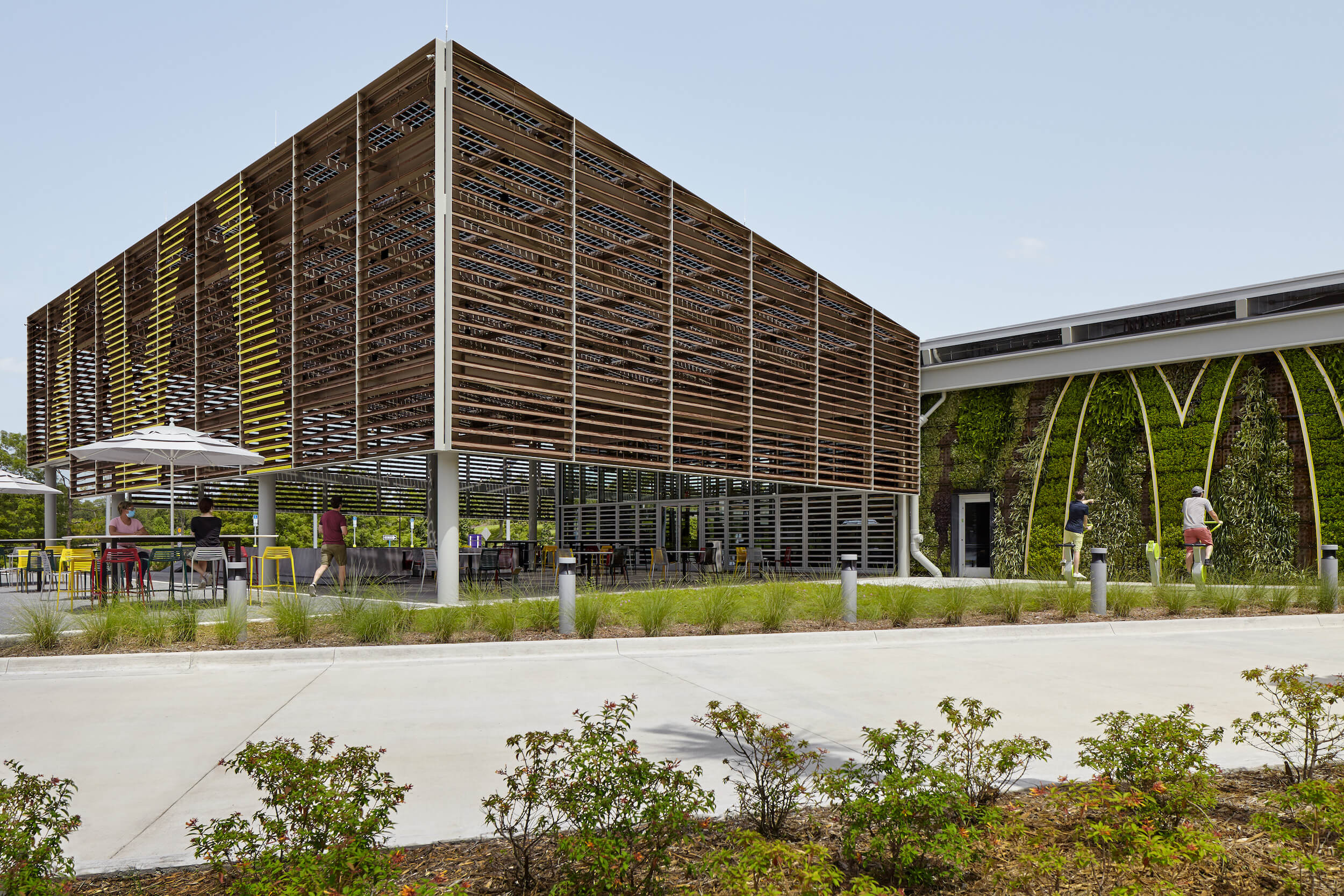
While there are similarities between both the Chicago and Disney World McDonald’s flagships, the latter is its entirely own creature particularly with regard to how it responds to Orlando’s subtropical climate. Enabling the building to be naturally ventilated for a majority of the year are large, sensor-controlled glass jalousie windows that open and close automatically based on temperature and outdoor humidity. Roughly 65 percent of the time, the building can be cooled without air conditioning.
Enclosed by wood louvered walls and cooled by fans, the spacious outdoor dining patio area is also a climate-appropriate feature of the building. And considering its location in the Sunshine State, a nearly 19,000 square foot photovoltaic panel-clad canopy soars outwards from the building’s butterfly roof. While the canopy incorporates over 1,000 individual panels, the building’s glazing incorporates an additional 4,809 square feet of integrated panels. Even the parking lot’s 25 PV-equipped light fixtures produce more energy than the super-efficient restaurant uses according to the firm.
As mentioned, the design of the building embraces a narrative revolving around environmental education. Features like storytelling kiosks and environmental-themed graphics can be found throughout the restaurant, enlightening guests as to how the high-performance building’s renewable energy and efficiency features work and why they’re important. And in lieu of an outdoor play structure, there are a fleet of human-powered stationary bikes that harness the kinetic energy produced by pedaling to charge customers’ devices while also lighting up an informative graphic embedded into a massive living wall on the side of the building. Considered a pilot restaurant, these elements and others tested at the McDonald’s net-zero flagship could be incorporated into future locations as the company strives to meet its ambitious sustainability goals while keeping customers in the loop along the way.
True to its location, disembodied instructive voices—just like the ones you might hear while queued up for a ride in one of nearby theme parks— are also part of the dining experience at this singular McDonald’s. Specifically, the voices can be heard when the jalousie windows open and close, warning guests to take caution and keep away to avoid a little pinch although, as Ross Barney points out, a museum-style infrared curtain system halts the opening and closing process if a hand, for example, gets too close to the windows as they’re in motion.
“We recorded the [warning] message in our office,” said Ross Barney with a chuckle. “We’re the voice of this building—it’s a building that has the designer’s voice!”

As for the new McDonald’s flagship’s energy savings, it’s anticipated to use 35 percent less energy compared to its predecessor (704,791 kilowatt-hours per year versus 1,079,144 kWh per year) with all of the building’s consumption needs being met by its on-site photovoltaic system with excess renewable energy-produced juice to spare. Significant savings—roughly half—were achieved by employing new, high-efficiency cooking equipment to run on standby mode instead of being on literally all the time. Other energy savings were achieved through high-efficiency lighting systems and, as mentioned, less of a reliance on air conditioning.
“We wanted to see how effectively we could reduce the baseline energy use of this restaurant, so all of the design features are aimed at that reduction,” said Ross Barney. “That was the key.”
“The exciting thing about the project is that it is the first quick-service restaurant to get a net-zero certification so it will be exciting to see how this year goes,” added Ryan Giblin, a senior project manager at Ross Barney Architects who is also involved with the firm’s LEED-certified Aerospace Communications Facility at NASA’s Glenn Research Center in Cleveland. “And hopefully other corporations—and federal projects—will follow suit. Hopefully, this will be how things go from here on out.”






